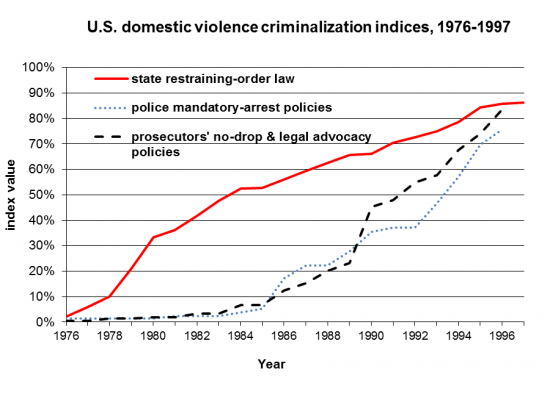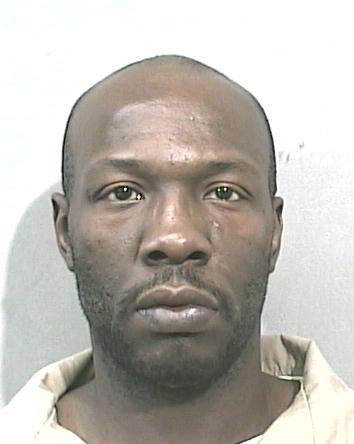
In 2009, the U.S. Department of Justice’s National Institute of Justice published, with the usually disclaimer, a ninety-six page Special Report entitled Practical Implications of Current Domestic Violence Research: For Law Enforcement, Prosecutors and Judges. That report makes clear that anti-men gender bigotry is deeply entrenched in current domestic violence research. To provide equal justice under law, law enforcement agencies, prosecutors, and judges must take seriously the practical implications of anti-men gender bigotry in addressing domestic violence.
Practical Implications of Current Domestic Violence Research deserves careful study. This major, government-funded research review sought to inform practice:
The purpose of this work is to describe to practitioners what the research tells us about domestic violence, including its perpetrators and victims, the impact of current responses to it and, more particularly, the implications of that research for day-to-day, real-world responses to domestic violence by law enforcement officers, prosecutors and judges.^
Domestic violence law typically encompasses violence among family or household members. Domestic violence thus includes parents’ abuse of their children or co-residing children, as well as violence among adult relatives or roommates. While Practical Implications repeatedly refers to domestic violence, it uses the term domestic violence to mean intimate-partner violence.^ Intimate-partner violence, a subset of domestic violence, is more easily gender-stereotyped as men victimizing women. The report’s use of “domestic violence” to mean “intimate partner violence” is significantly misleading.
Practical Implications tendentiously ignores much research indicating that men account for a large share of victims of criminalized domestic violence. Scholars writing in peer-review publications have argued bitterly for decades right up to the present over the share of men who are victims domestic violence or intimate-partner violence. Practical Implications acknowledges that controversy with one dismissive reference to a book published in 1980.^ Practical Implications completely ignores domestic-violence scholars who have seriously challenged gender stereotyping.^ It predominately cites research based on gender-stereotyped intimate-partner violence. That’s not an intellectually responsible approach to reviewing intimate-partner violence research.
Practical Implications encourages criminal suspicion of men. It poses the question, “Do male domestic violence victims differ from female victims?” A reasonable answer might recognize that male domestic violence victims have long been ignored. A reasonable answer might point out that services for male victims of domestic violence are far inferior to those for women victims. A reasonable answer might recognize that the criminal justice system has been oriented toward arresting and prosecuting men, not serving men as victims of domestic violence.
Practical Implications instead promotes unreasonable criminal suspicion of men for domestic violence. Here is the report’s short, two-paragraph answer to the question of how men differ from women as victims of domestic violence:
- Research on domestic violence victims brought to the attention of law enforcement and the courts find that male victims differ substantially from female victims. First and foremost, male victims of any specific domestic violence incident are more likely than female victims to be future suspects for domestic violence. …
- Similarly, male victims of domestic violence homicides are much more likely than female victims to have been identified previously as abusers of their eventual killers. ^
These declarations prejudicially cast criminal suspicion on men that police officers have identified as victims of domestic violence.
Practical Implications encourages law enforcement, prosecutors, and judges to re-categorize female domestic suspects as victims. The report also encourages sex-biased charging and sentencing practices that favor women. Practical Implications declares:
Implications for Law Enforcement
Specific incidents of domestic violence may not reveal longer term domestic violence patterns, particularly if the suspect is a female and the victim is a male. Police should acknowledge this and encourage suspects who are more typically victims to report future victimization, notwithstanding their current suspect status.Implications for Prosecutors and Judges
Specific incidents of domestic violence may not reveal longer term domestic violence patterns, particularly if the suspect is a female and the victim is a male. Prosecutors and judges should be sensitive to this fact in charging and recommending sentences for such defendants and in issuing protective orders or fashioning sentences.^
If practitioners don’t recognize here encouragement to gender-profile men for arrest and punishment for domestic violence, the report offers more direct, quantitative recommendations. Practical Implications offers a desultory review of statistics on the share of men in state action addressing domestic violence (re-defined in this report to mean intimate-partner violence):
Perpetrators that come to the attention of the criminal justice system are overwhelmingly male. For example, 86 percent of abusers brought to court for restraining orders in Massachusetts were male, as were those arrested for domestic violence in California and Charlotte, N.C. (as much as 97.4 percent for the most serious cases). In Rhode Island, 92 percent of abusers placed on probation for domestic violence were male. A Cincinnati court study found 86.5 percent of 2,670 misdemeanor domestic violence court defendants to be male. The overwhelming majority of their victims were women: 84 percent in both Charlotte, N.C., and Berkeley, Calif. The 2000 NIBRS multistate study found that 81 percent of the suspects were male and their victims were female. ^
The most nationally representative statistic in that collection is the last mentioned, NIBRS data. NIBRS data for 2000 and 2010 indicates that 78% and 75%, respectively, of persons arrested for domestic violence are male. Practical Implications goes on to offer one-sided numerical standards for justice:
Implications for Law Enforcement
If the ratio of male to female suspects and victims differs substantially from those found above, departments should be alert to potential gender bias in their response to domestic violence. Ongoing training and supervision can address overrepresentation of female versus male arrests.Implications for Prosecutors
Prosecutors should be alert to gender bias in the response of local law enforcement agencies and re-screen cases if the percentage of female suspects accused of abusing male victims exceeds that commonly found across the nation.Implications for Judges
If, upon reviewing domestic violence dockets, judges find much higher rates of female-on-male abuse cases than those typically found across the country as a whole, they should be alert to potential gender bias on the part of police and/or prosecutors and ensure that they are presented with sufficient evidence to confirm the correct designation of victims and their abusers.^
These implications address only monitoring whether the the share of females arrested for domestic violence is too high. Men account for about 75% of persons arrested for domestic violence. Credible, nationally representative data on hospital emergency department visits indicate that men account for 42% of hospital visits due to domestic-violence injuries. The justice system currently gender-profiles men for arrest for domestic violence. In contrast to the anti-men gender bigotry of Practical Implications, law enforcement, prosecutors, and judges should be concerned that the share of men among persons being arrested, prosecuted and convicted for domestic violence is too high. Concern for equal justice under law demands concern for men arrested for domestic violence. That’s particularly important in today’s circumstances of widespread anti-men gender animus in suspicion of domestic violence.
Practical Implications on dual arrests also indicates anti-men gender bias. Credible scholarly research indicates that about 40% of domestic violence is mutual.^ Practical Implications states:
A substantial percentage of victims of domestic violence hit their perpetrators back. … A substantial number of victims will not self-disclose their victimization. Consequently, determination of primary or predominant aggressor may not be self-evident.^
Nonetheless, Practical Implications recommends actions to lessen dual arrests:
Implications for Law Enforcement
If the rate of dual arrests exceeds that found on average across the country, law enforcement departments should develop and implement specific primary aggressor policies and protocols.Implications for Prosecutors
If presented with a dual-arrest case, prosecutors should conduct an independent analysis to determine the predominant aggressor and proceed against that suspect alone.Implications for Judges
In dual-arrest cases, judges should insist that prosecutors provide evidence that one of the parties was the primary or predominant aggressor and the other the victim. This may be particularly important, as advocates caution that female victims who are arrested along with their abusers may nonetheless plead guilty in order to be able to return home to care for minor children.^
According to Practical Implications, dual arrest figures above the national average indicate a problem, while dual arrest figures below the national average aren’t of concern. The “problem” of dual arrests for domestic violence is addressed through primary aggressor policies and protocols. These policies and protocols gender-profile men for arrest for domestic violence. Showing contempt for the difference between judges and advocates, the “implications for judges” come from advocates’ gender-role-based special pleading:
advocates caution that female victims who are arrested along with their abusers may nonetheless plead guilty in order to be able to return home to care for minor children.
In discussing dual arrest, the “implications for judges” refers to arrested women as “female victims who are arrested along with their abusers.” The report provides no indication of how to identify such women beyond their sex. It doesn’t acknowledge the possibility that among the much greater number of men arrested for domestic violence, some of those men are “male victims who are arrested along with their abusers.”
Practical Implications supports broad criminal suspicion of men for domestic violence. Domestic-violence calls to police numbered about 4 million per year in the U.S. in 2008. Under the question, “Which victims are likely to report domestic violence?” Practical Implications reports:
Implications for Law Enforcement
When a victim reports domestic violence, it probably indicates repeated prior abuse incidents.^
In response to the prejudicial question, “How many abusers are likely to do it again?” Practical Implications encourages conclusion justice-system action:
Implications for Law Enforcement
It is safe to assume that, more often than not, the typical abuser who comes to the attention of law enforcement has a high likelihood of continuing to abuse the same or a different victim, both in the short term and over the subsequent decade at least.Implications for Prosecutors and Judges
It is safe to assume that, more often than not, the typical abuser who makes it to the prosecutor’s office has a high likelihood of continuing to abuse the same or a different victim, both in the short term and over the subsequent decade at least. While prosecuting specific, discrete incidents, prosecutors should recommend sentences that address long-term patterns of criminal behavior and are based on abuser risk for reabuse. Judges should fashion civil or criminal remedies/sanctions that maximize protection of current and/or future victims from the abuser.^
These prejudicial implications point in the direction of harshly punitive criminal justice system response to roughly four million domestic violence police calls per year. In 2009, the U.S. held 2.2 million persons in prison and jails on any given day. Among the incarcerated, men outnumbered women by ten to one. Practical Implications in effect suggests that highly sex-biased U.S. mass incarceration should be expanded enormously.
Practical Implications indicates that consideration of case-specific facts has little relevance to punishment for domestic violence. Under the question “What factors are not associated with reabuse?” Practical Implications suggests that many facts don’t matter:
Generally, the seriousness of the presenting incident does not predict reabuse, whether felony or misdemeanor, including whether there were injuries or not, or what the specific charge is. Abuser personality types have not been found to be associated with increased risk of reabuse. Actuarial data offer improvement over clinical data. Victim characteristics, including relationship with abuser, marital status, and whether the parties are living together or separated, have not been found to predict reabuse. At least one study has found that victim cooperation does not predict recidivism.^
One implication is that gender bigotry, rather facts, can easily dominate the criminal justice response to allegations of domestic violence. According to the report, the implications are that law enforcement, prosecutors, and judges should be more concerned with (biased) beliefs about generic future risks than with actually committed acts:
Implications for Law Enforcement
Criteria for charges should not be confused with criteria for determining future risk. Abusers cited for misdemeanors are as likely to be dangerous as those charged with felonies.Implications for Prosecutors
Criteria for charges should not be confused with criteria for determining future risk. Abusers charged with misdemeanors are as likely to be dangerous as those charged with felonies. If the offense against a dangerous defendant is not chargeable as a felony, prosecutors should explore the applicability of enhancement statutes for repeat offenses, multiple charges if appropriate, or maximum allowable sentencing recommendations.Implications for Judges
Criteria for charges should not be confused with criteria for determining future risk. Abusers charged with misdemeanors are as likely to be dangerous as those charged with felonies. Although constrained by statute, judges should seek to minimize offender risk to the maximum extent allowable by law.^
Practical implications for the burden of proof are explicit:
Implications for Law Enforcement and Prosecutors
Given high base rates of reabusing, the default presumption should be that the defendant is likely to reoffend until proven otherwise. Risk instruments do not significantly improve upon victim perception and basic actuarial data.^
Suspects are to be presumed to be guilty of future offenses unless proven otherwise. Proving innocence of future offense is, of course, infeasible. The reference to “basic actuarial data” refers misleadingly to the bitter scholarly controversy over the gender distribution of domestic violence:
Of course, the most powerful predictor of risk of domestic violence is gender. All of the research concurs that males are more likely to reabuse than females.^
Predicting likelihood of reabuse is much more difficult than evaluating actual abuse. Actual acts, rather than expert prediction, is a much sounder basis for punishing individuals. Orienting domestic-violence punishment to “basic actuarial data” replaces difficult, important justice system responsibility with merely ratifying the power and control of anti-men gender bigotry in Practical Implications and much other domestic violence research.
Practical Implications of Current Domestic Violence Research: For Law Enforcement, Prosecutors and Judges has broad implications for domestic violence policy, the criminal justice system, and deliberative democracy. Administering equal justice under law is a core responsibility of the state. Family law is constitutional law in everyday life. Domestic violence now accounts for the majority of arrests for interpersonal violence. Particularly in circumstances of extraordinarily high incarceration prevalence and highly disproportionate incarceration of men, more aggressive criminalization of domestic violence should require compelling public reasons.
Practical Implications shows that deliberative democracy and public reason are failing badly. Anti-men gender bias is embedded even in large statistical surveys, technical reports, and statistical overviews issued by major U.S. statistical institutions. Practical Implications highlights the need to develop new approaches to public information, democratic discussion, and democratic accountability.













